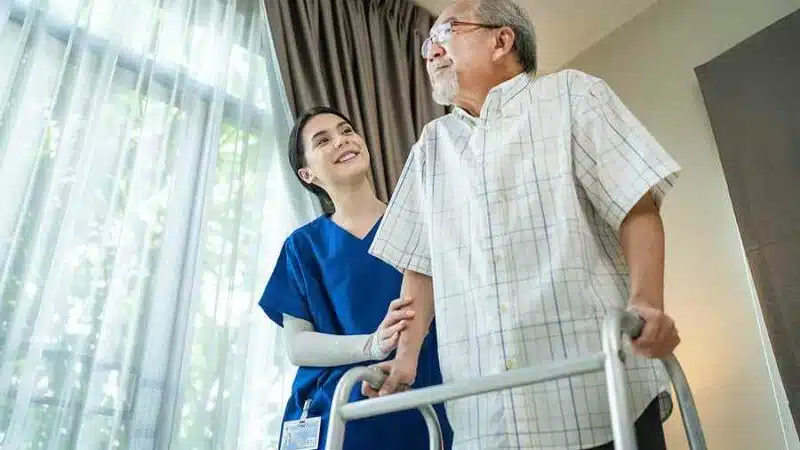Top Fitness Routines For The Golden Years

Aches and pains are an expected part of aging but in many cases, they can happen prematurely, seriously adversely affect the quality of life in a senior adult.
They can also be indicative of medical problems and diseases.
As any medical professional will tell you, pain is a tell-tale sign that something is wrong and it is often a useful marker for diagnosticians.
Causes And Origins Of Age-Related Pain
As people get older they start suffering in many cases from multiple simultaneous conditions and effective pain management becomes more important for their daily activities.
The pain threshold decreases in older adults due to a general weakening of the body and that is partially the cause for age-related pain. Some other causes are as follows;
- Having A Fall– Senior adults are more susceptible to falls and subsequent fractures and injuries. These injuries can take longer to heal than they would in a younger person and may result in multiple surgeries or other corrective procedures.
- Osteoarthritis and osteoporosis are two common causes of joint pain and degeneration and have a high rate of occurrence in both men and women. Rheumatoid arthritis and other autoimmune conditions can worsen with age and be a major cause of chronic pain.
- Lower-Back Pain– A great majority of people over the age of 60 suffer from lower back pain regardless of whether they had sedentary desk jobs or field or physical jobs that kept them on their feet. Tumors, infections, and conditions like lumbar spinal stenosis can change the structure and shape of the spine making normal day-to-day functioning very difficult.
- Stiffness of Muscles And Inflammation– Muscle stiffness is commonly associated with age as water and collagen loss happens and muscles stop being used as much. Conditions like tendonitis which is essentially an inflammatory response in the tendons and muscles can worsen this type of age-related pain. Bone pain such as elbow or knee pain can also be a precursor to inflammatory conditions like arthritis and can cause extra weight gain that further puts the elderly at risk of heart disease and diabetes.
- Age-Related Conditions– In many cases diseases and conditions like diabetes or gout can be responsible for recurrent pain. As mentioned above, diseases like inflammatory or rheumatoid arthritis are mostly to blame with heart disease and cholesterol or diabetic neuropathy being close seconds.
Solutions, Enhancing Quality of Life & Preventative Diet
Exercise is a key way to keep illnesses at bay as it optimizes weight, keeps muscles in good shape, and prevents bone loss.
It is advisable that elderly people consult with their doctor before implementing any exercise regimen particularly if it is a higher intensity kind that their bodies are not used to.
Undergoing physical therapy or visiting a pain management doctor after injuries or fractures is paramount in maintaining good mobility in the later years of one’s life.
Exercises such as swimming, walking, and jogging can strengthen a person’s lungs, bones, and joints making them more active and mobile even as they get older and lessening the occurrence of pain.
Sedentary living has been linked with an increased risk of heart and blood sugar problems that can cause different kinds of pain such as headaches and angina among others.
Mobility equipment such as mobility scooters or walkers can be helpful for people who have suffered from bone-related injuries or have joint-related inflammatory conditions.
Changing the way you eat has the most tremendous impact on conditions of chronic age-related pain.
Elderly people should consume an antioxidant-rich diet with plenty of protein and should consider taking a collagen supplement as well as supplements of vitamins D, B, and E along with Omega 3, 6 and 9 fatty acids commonly found in flaxseed or fish oil soft gels.
Supplements can interrupt the inflammatory processes behind pain and have various health benefits over the long term.
A diet that is geared toward preventing bone loss or joint pain is imperative for effective pain management in geriatric patients.
Loss of appetite is common as a person ages so nutrient and vitamin deficiencies occur and specialized powder formulas for the elderly can fill important nutritional gaps.
Fruits and vegetables are a staple for the pain management diet, especially foods rich in magnesium which relaxes the nerves.
Consuming fish at least three times a week is important for anti-inflammatory processes but a supplement works if fish is hard to get by in its fresh form.
Superfoods like kale, spirulina, moringa, and chia seeds among others lessen pain, boost detoxification, and help prevent age-related diseases.
Achieve toned and strong arms with effective exercises tailored for individuals over 50, and learn about proven methods to combat flabbiness in this article. Discover five practical ways to sculpt your arms and enhance your fitness routine on LifeOver50





